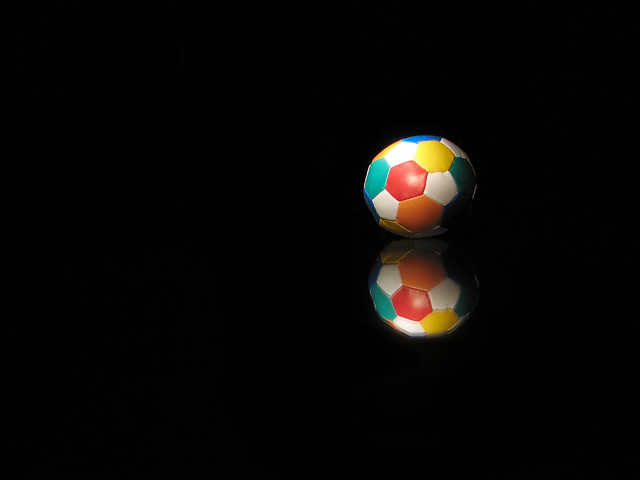Good photography requires a combination of technical expertise as well as artistic creativity. Unfortunately, the rise of digital technology has focused the attention of many beginners on the purely technical aspects of photography. All too often, the artistic side of photography is neglected.

“Flashlight [3]” captured by Rick Harris
Where to start?
Well, most experienced photographers will tell you the best place to start is the Rule of Thirds.
What is the rule of thirds?
It is a sort of guideline to help you structure your composition in a balanced way that pleases the eye. Like all rules, it is made to be broken, but we’ll look at that later. Experience will give you the confidence to decide when you need to apply the rule of thirds and when you can get by without it. However, before you can make that decision, you need to understand the rule and how it works.
Imagine the rectangular shape of any photograph. Now draw a horizontal line one third from the top of the frame, and another one third from the bottom. Then draw a vertical line, one third from the left, and another one third from the right. Your rectangle should now be divided into nine equal sections.
According to the rule of thirds, the lines that divide the picture into thirds are the most effective places to position objects in your photo. So, for example, the horizon should be positioned on or near the line a third from the top or a third from the bottom of the picture. Vertical objects like trees should be placed on or near the lines a third from the left or right of the picture.
Also according to the rule, the most powerful points in the composition are the areas where the lines intersect. So, if your horizon is a third from the top of the frame, a house or tree on the horizon would be best placed a third from the left or right, at the intersecting point of the horizontal and vertical lines. If you have positioned a tree along one of the vertical lines, a bird sitting in a fork of the tree would be best positioned where it intersects with the horizontal line a third from the top.

Photo by J J; ISO 200, f/3.5, 1/30-second exposure.
If this seems hard to follow, sketch it out, and it will start to make sense.
If this seems a little too structured and organized for the real world, that’s because in most cases it is. After twenty years in photography, I can tell you that nature is not so neatly packaged for our convenience. You cannot expect all the objects in your photos to fall into place according to the Rule of Thirds. However, by using the rule as a general framework, you can begin to create structure in your photography
Why does the rule of thirds work?
Don’t know, don’t need to know. But it does work. It satisfies our sense of visual proportion, so that photos structured in this way appear balanced in the eye of the viewer. You can prove this for yourself right now, just by looking at a book of your favorite photos. When you apply the framework to each picture, you will probably find that most of them, at least loosely, fit the rule of thirds.
Many photographers have a natural sense of visual balance. They take their photos according to the rule of thirds without being aware of it. They may simply shoot the picture that ‘looks right’ or ‘feels right’ to them, unconsciously applying the rule as they go. For new photographers who are struggling with composition, this simple guideline will make a world of difference. In time, and with experience, these beginners will develop their own natural ‘feel’ for composition.
Am I suggesting that every photo must be taken using the rule of thirds? Is any photo that falls outside these guidelines a failure? Absolutely not.
Some photos are made more effective by deliberately ignoring the rule of thirds. It is possible to focus the viewer’s attention on a particular feature, by positioning it where we would not normally expect to see it. Shaking up the viewer’s sense of visual balance can add real impact to a photo if it is done well. I can give you a very simple example from my field of nature photography.
A sunset photo is usually all about the sky. A photographer can add impact to the sky by lowering the horizon to well below the ‘normal’ horizon level. The result will be a sky that really towers over the foreground and imposes more strongly on the entire picture.

“The Spotted Eagle” captured by Richard Schneider
There are probably millions of other examples of great photos that were taken outside the framework of the rule of thirds. As I said at the start, all rules are made to be broken. That does not mean that photographers should not know the rule and practice it. There’s no harm in breaking with convention. The important thing is that you do it knowingly and for a reason, to make your photos more effective. Breaking the rules is a lot more fun when you understand the rules you’re breaking.
About the Author:
Andrew Goodall writes for http://www.naturesimage.com.au and is a nature photographer based in Australia. He manages a gallery in Montville full of landscape photography from throughout Australia.
Like This Article?
Don't Miss The Next One!
Join over 100,000 photographers of all experience levels who receive our free photography tips and articles to stay current:






The ‘Rule of Thirds’ is now among the worst thing to happen to photography – Why should there be any rules in what ultimately is a creative activity? Rules are designed to make things accurate, predictable and repeatable—pretty much the opposite of what you’d want from an interesting, surprising photograph. It’s probably the worst piece of advice regarding composition I can imagine.
It should be obvious that if all photographs were composed like this, they would just be similar and boring and the evidence is everywhere to be seen, same old compositions, same old tired approaches – what makes it even worse is that every guide to photography repeats it and camera club competition judges and amateur critics use it as an absolute yardstick of ‘quality’.
Think of any photographs that have inspired you (not just caused you to ‘like’ them on social media). How many are divided into thirds? The real puzzle to me is why it gets repeated so often.
I totally agree with Nathan when he says “Observing the sacred rule of thirds will no more transform a boring picture into a work of art that is timeless forever ………”
In answer to Faylinn. Always ignore the rules. They are completely irrelevant. Let your heart tell you what to do.
Nonsense. Rules for fools is what I call them. The only rules that must be observed is that of beauty and harmony. Observing the sacred rule of thirds will no more transform a boring picture into a work of art that is timeless forever is a fantasy on the same level as thinking that getting a newer lens or more sophisticated camera body will make you a great photographer. All any of them do is make it easier, and quicker, to make pictures that mean nothing.
I just started taking a photography class and so I am learning about the rule of thirds. I feel like I am getting a handle on the concept, but how do I know when I should ignore the rule? I’d also be interested in knowing when a photo should be centered and not abide by the rule too.
Rule of 3rds is not quite right. Strong points should be decided by using a Fibonnaci series, as follows:
Divide the horizontal measurement into ElGHT equal parts, Now drop verticals at the 3 and 5 positions
Do the same for the vertical side.
Where these lines intersect are the true strong points
3, 5, and 8 are Fibonnaci numbers